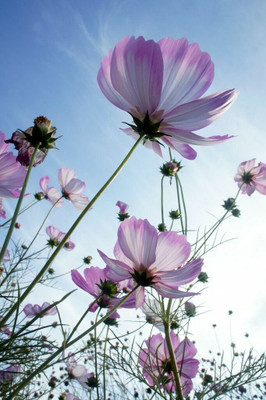ZIXA Purple Cosmos Seed(20 per packet)
Quick Overview
Product Price Comparison
Flowering season: They bloom starting from early summer until frost.Growing Tips for CosmosSoil: Soil pH 6.0 to 6.8. is the best for these plants. However, owing to their ability to sustain in adverse conditions as well, they can grow easily in poor soil too. Adding some organic matter to the soil will help them get the well-draining soil that they prefer.Sunlight: For the best flowering, plant Cosmos in full sun. In very hot locations, consider planting Cosmos in areas where they receive some afternoon shade.Water: Regularly, whenever topsoil turns dry. Keep the soil moist but not soggy. To avoid rot and fungal diseases due to over-watering.Sowing season: Spring.Sowing methods: You can sow them outdoors, however, in colder climates it's best that they grow indoors. Try to aim for a seed spacing of at least 2.5 cm and so at a depth of around 0.64 cm. Soil temperature should be kept higher than 20oC to ensure good germination.Harvest:Harvest flowers at any time after the plantŌĆÖs bloom, but when it should be fully bloomed flowers.Put cut flowers in deep water immediately to prevent wilting.Care:When Cosmos finishes flowering, deadhead the plants by cutting off all of the dead flower blossoms. Deadheading will encourage the plant to produce more flowers and help the plant to fill out properly.Pinch off any extra stems or shoots growing up from the base of plants. This will also encourage stronger more vigorous growthCosmos plants may require staking especially in exposed locations to keep them from falling over. Staking Cosmos provides some protection from strong winds.Water these regularly, but make sure you don't over-water the plants. Over-watering and over-fertilization can lead to plants with fewer flowers. Cosmos beds may become weedy due to the fact that they self-seed, so remember to check them.Pests and Disease:Two of the most common fungal diseases of plants, Fusarium wilt and powdery mildew, can also plague cosmos plants.Fusarium wilt not only causes the plant to wilt but discolors the stems and foliage. The whole plant, unfortunately, is going to die and should be destroyed to avoid spreading the fungus.Powdery mildew spores float on the breeze and will attach to any host plant in shade. The fungus forms a powdery white coating over leaves, which will eventually cause foliage to yellow and drop off if left untreated. Plants with good ventilation, in bright light and that are watered in the day so foliage can dry are not as susceptible to fungal diseases of cosmos Aphids, including aster root aphids, spirea aphids and melon aphids, thrips and plant bugs are some common pests may infest cosmos plants. Aphids can spread fungi and viruses, thrips can scar leaves and flowers, and plant bugs suck juices from leaves, leaving them with a stippled appearance. Beneficial insects and other predators that are attracted to cosmos may be sufficient to control insect pests. Otherwise, use neem oil, insecticidal soap or petroleum-based insecticides to control these pests.Planting Cosmos flowers in the garden will add bright colorful and tall flowering background material in the annual border, they attract birds, bee, butterflies and beneficial insects to garden with low to no maintenance.This makes Cosmos a colorful winner in any garden.


